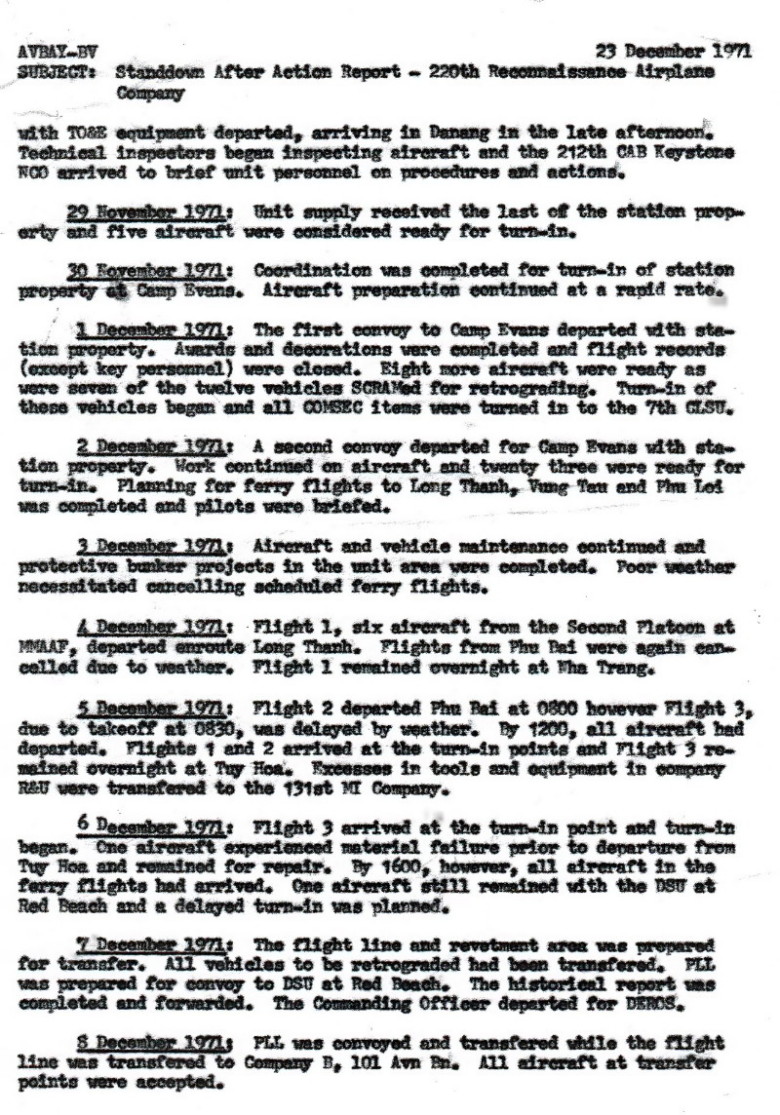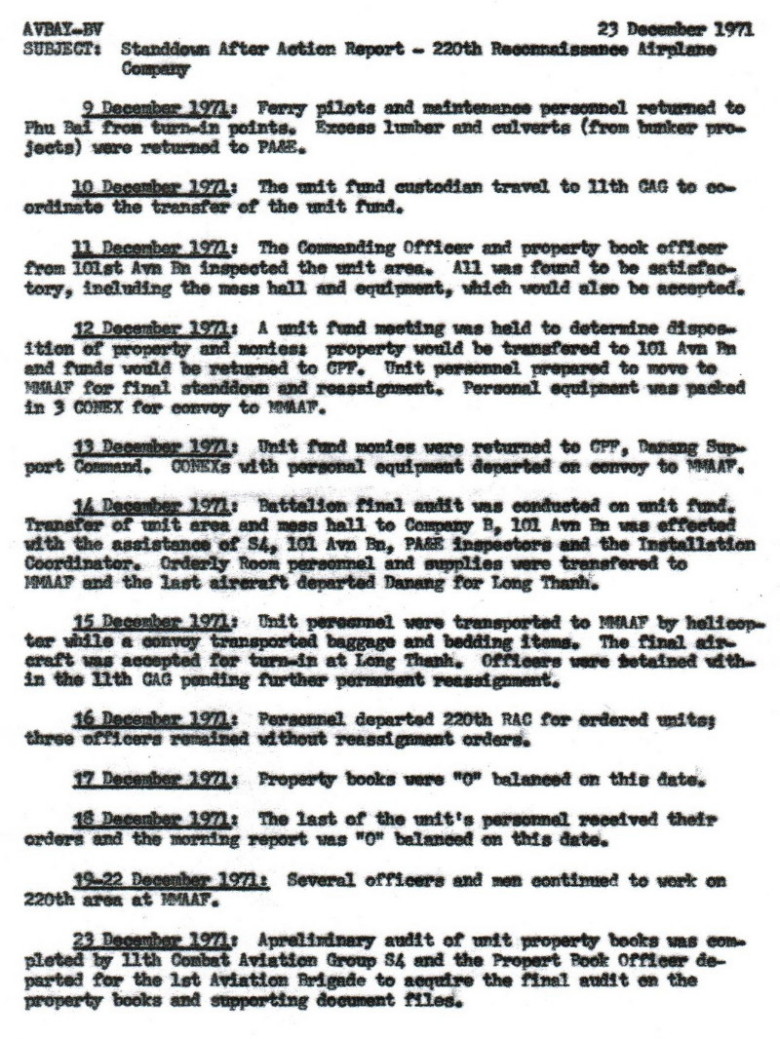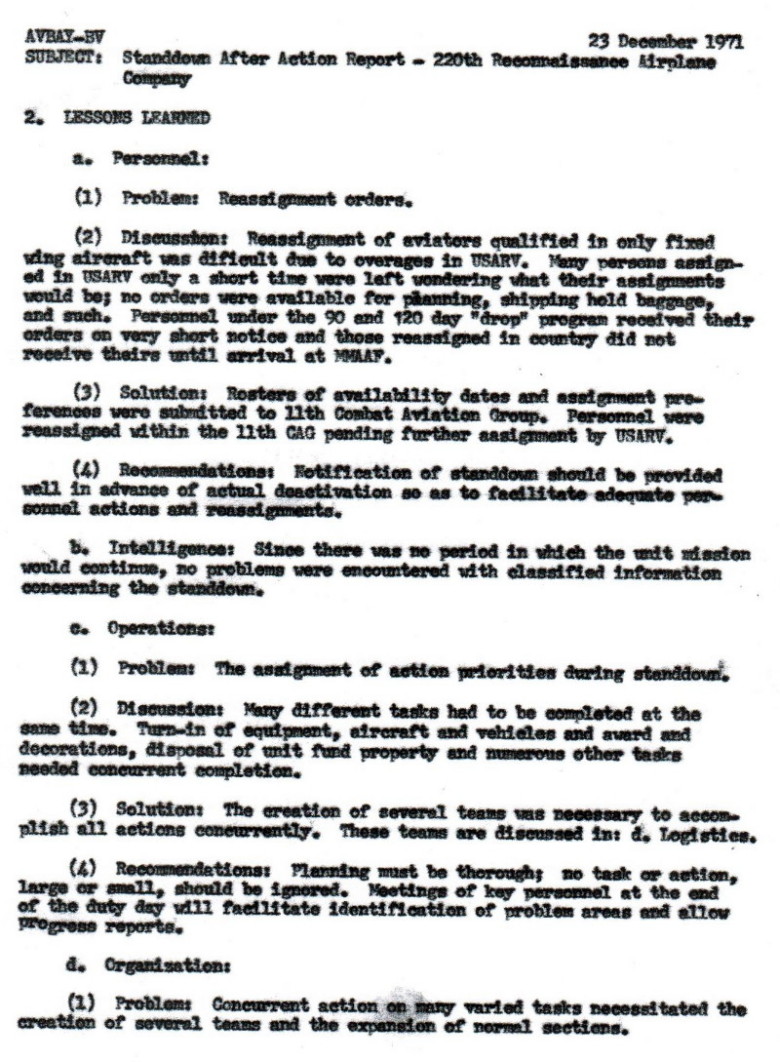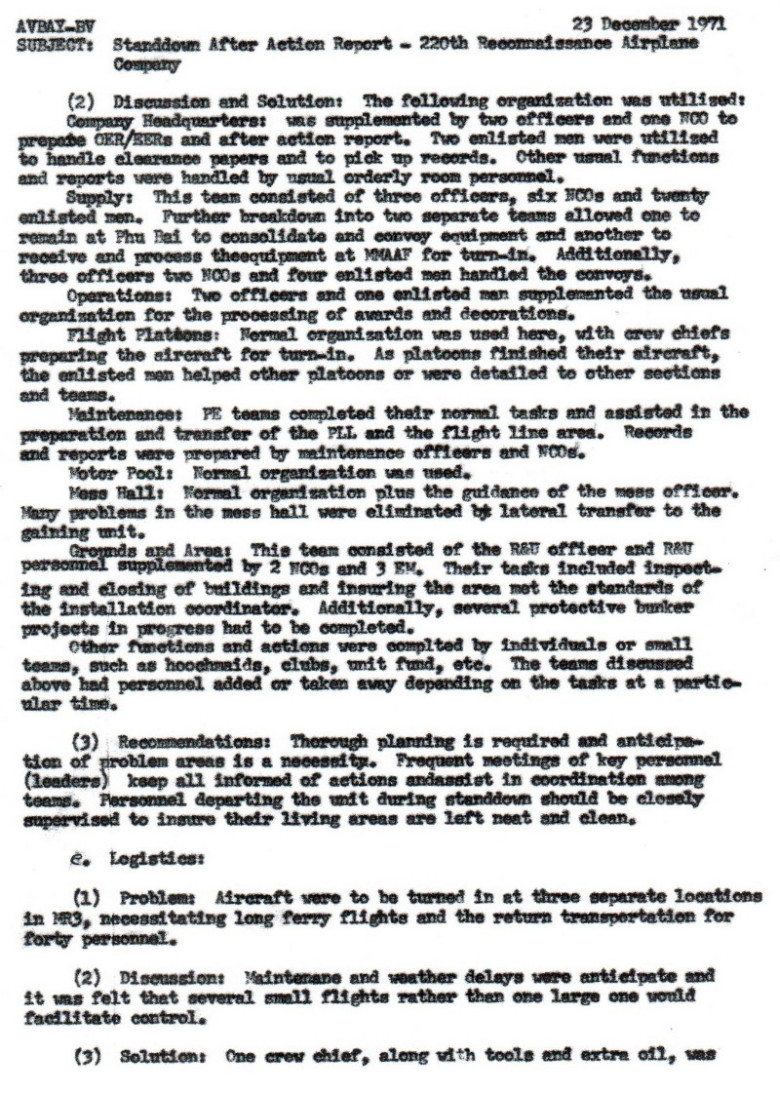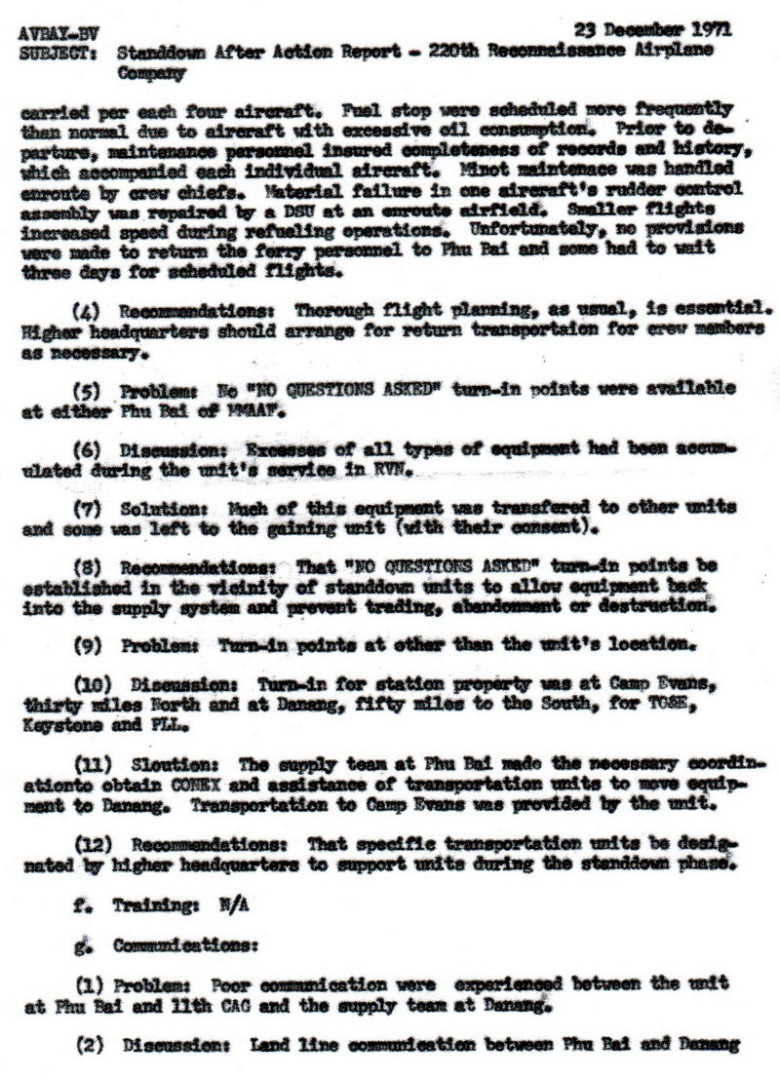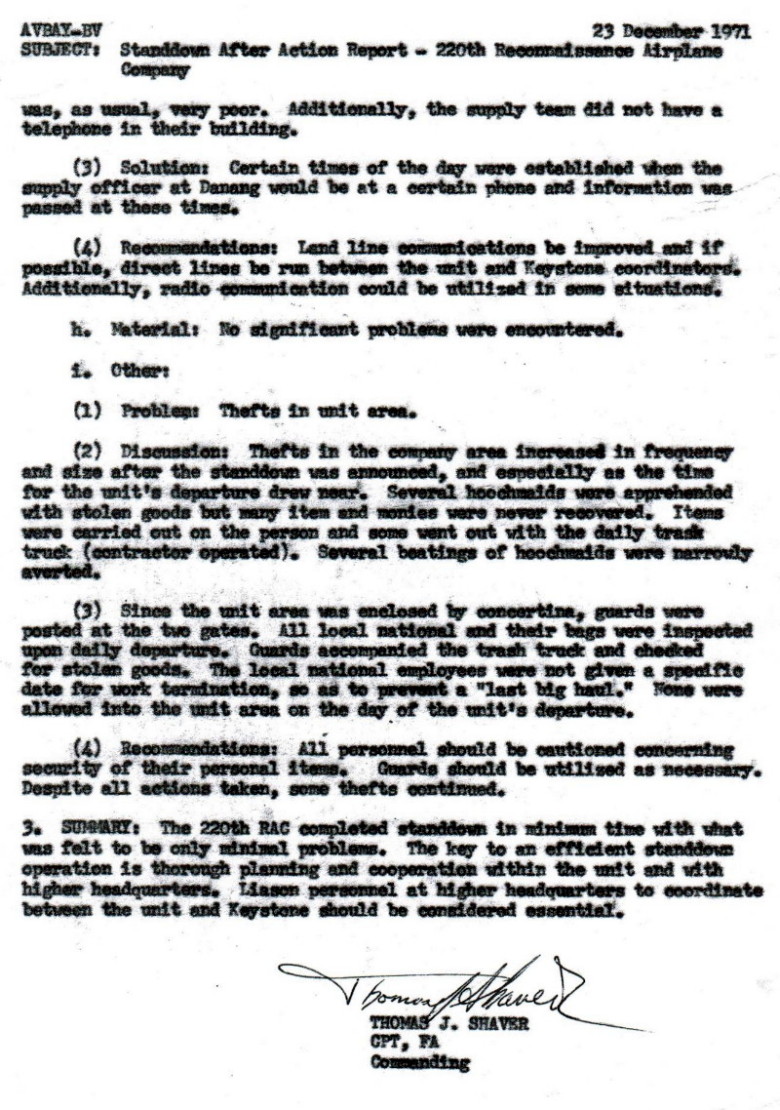
History of the 220th Aviation Company—1971
Overview
by Gene Wilson
On 5 January MAJ Guinn passed command of the Company to MAJ Darryl W. Johnson.
During the opening of this year the 1st Platoon flew in support of the 1st Brigade, 5th Mechanized Infantry Division until the Brigade redeployed to the United States in July. The primary areas of operation of the 1st Platoon were the Khe Sanh and DMZ areas in Quang Tri Province. The 2nd Platoon continued to fly in support of the ARVN 1st Division in the A Shau Valley and surrounding regional area. The 3rd Platoon supported the 101st Airborne Division in the A Shau Valley, Khe Sanh and the DMZ Tri-Borders area. The 4th Platoon supported the 108th Field Artillery Group until they redeployed to the United States and then the 4th Platoon began to perform more of a general support role throughout the entire area of operations in northern I Corps.
On 1 February the 1st and 4th Platoons began support of the Dewey Canyon II Campaign, commonly known as the Lam Son 719, in the offensive along Highway 9. Both platoons operated over Eastern Laos. Observer pick-ups were made at Quang Tri, until operations were moved to Khe Sanh in late February. However, due to several concerns and issues, by late March both platoon operations were withdrawn from Khe Sanh with operational support being based out of Quang Tri and Dong Ha. Some 2900 hours of support were flown during this operation. The 2nd and 3rd Platoons continued to operate in the A Shau Valley and in the DMZ while also retaining a reserve mission to the 1st and 4th Platoons.
NOTE: Al Paulsen, who was the Operations Officer at this time, related the following to me: Although Dewey Canyon II and Lam Son 719 are often lumped together, they were actually two separate consecutive operations with their own start and end dates. As the result of concern at MACV about the potential of an all-out NVA attack on Hue being mounted, a plan to regain the offensive, disrupt any NVA plans and turn more of the responsibility for fighting the war over to South Vietnamese fighting forces, planning for Operation Dewey Canyon II, the American prelude to Lam Son 719, began on 7 January. The mission of the 1st Brigade, 5th Mech Inf Division, was to clear and secure Highway 9 from Dong Ha to the Laotian border, secure the primary base of operations at Khe Sanh, secure FSB Vandergrift and Lang Vei and conduct intensive patrolling in those areas and along Highway 9 to prevent any counterattack to the follow-on operation by the South Vietnamese forces in the incursion into Laos. During this time, Al and Dennis O´Connor, the Company XO, flew to Khe Sanh and met with BG Hill, the CG of the 1st Brigade, to discuss the mission of the 220th support out of Khe Sanh. Operation Dewey Canyon II then actually began on 30 January and ended on 7 February. Operation Lam Son 719 then followed on the next day, 8 February, with vast US helicopter, artillery and air support. The operation in Laos ended 45 days later when the last of the surviving South Vietnamese forces were evacuated on 25 March and Lam Son 719 was effectively over.On 17 March MAJ Johnson submitted the attached letter to the Chief of Military History requesting a Special Designation for the 220th Reconnaissance Airplane Company.
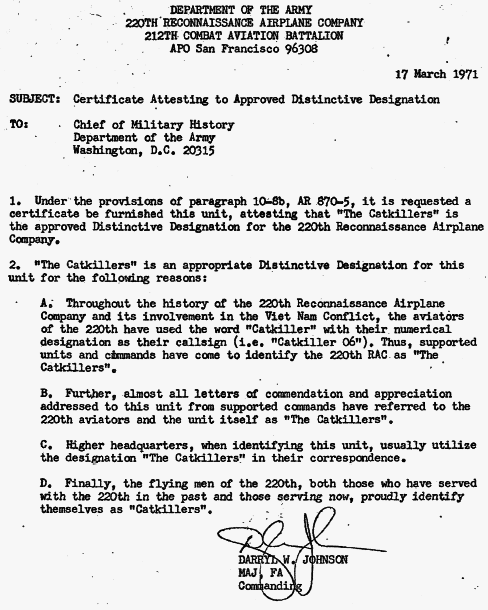
On 22 March CPT Harold P. (Paul) Bordeaux earned an impact award of the Silver Star on a mission in support of Lam Son 719.
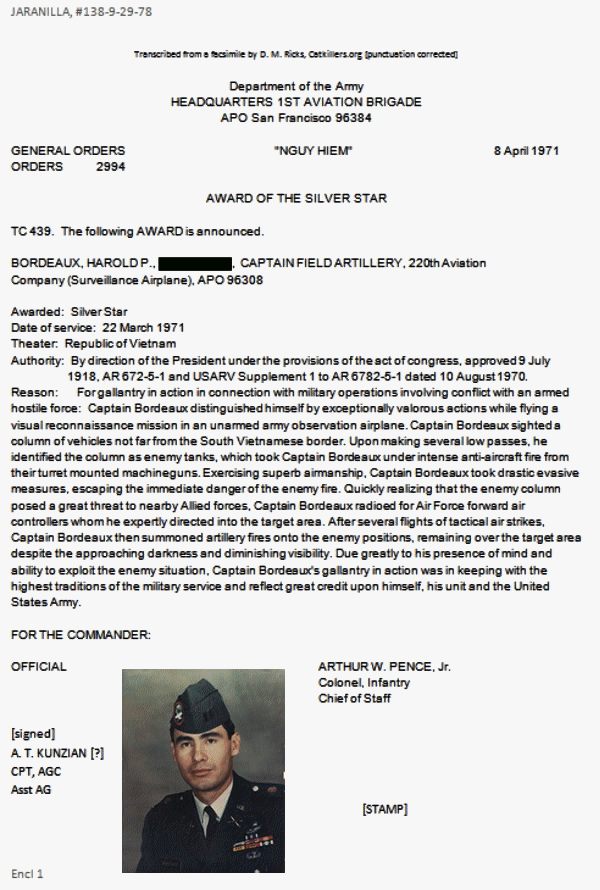
On 6 April the base at Khe Sanh was abandoned—and its service to Quang Tri Province and northern I Corps was left to history.
As the result of the letter written by MAJ Johnson to the Chief of Military History, the Department of the Army granted the following certificate:
THIS IS TO CERTIFY THAT THE 220TH AVIATION COMPANY
HAVING REQUESTED PERMISSION TO ACCEPT IN TRUST A
SPECIAL DESIGNATION UNDER WHICH IT WILL CONTINUE
TO RENDER LOYAL AND FAITHFUL SERVICE IS HEREWITH
AUTHORIZED TO ACCEPT THE DISTINCTIVE DESIGNATION
THE CATKILLERS
Given Under My Hand in the City of Washington
this 26th day of April 1971
(Signed)
Stanley R. Resor
Secretary of the Army
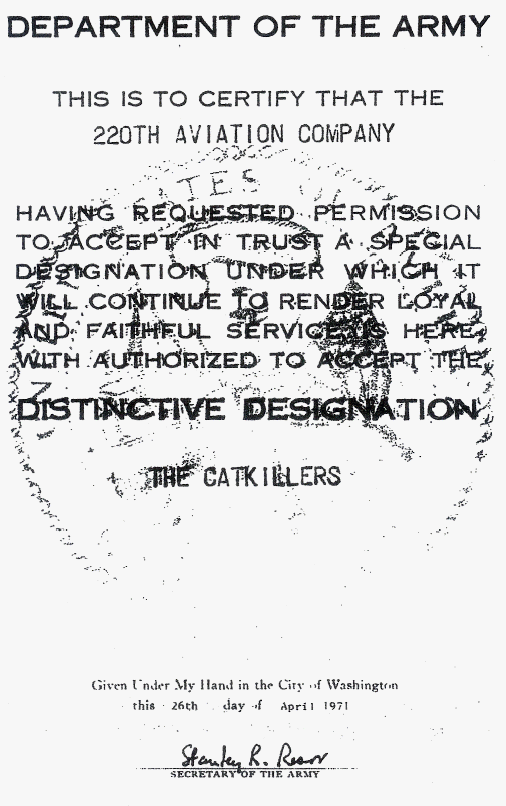
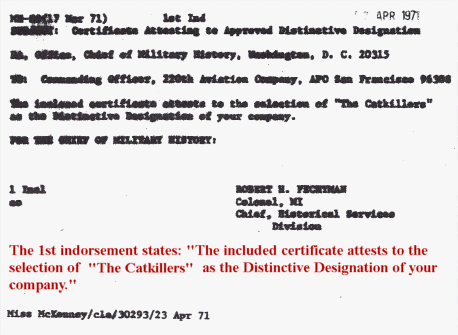
NOTE: As I have worked through the evolution of the 220th Aviation Company unit patches and prepare a separate addendum for that series of events, it is probably just as fitting that I tell the "rest of the story" as I have tracked it concerning the facts, as I found them, surrounding the 220th nick-name and Special Designation. While I have not been able to locate him and discuss the situation with MAJ Johnson, his letter did accomplish the job with a favorable response being received. However, there are some statements that were written in justification for the designation that do not track with the history of the unit (it is interesting to note that there were no attachments or enclosures included, which apparently were not required for such a request, and it was not routed through any higher headquarters in the chain of command to fully support the statements that were made in the request). It also further appears noteworthy that while the request was for a Distinctive Designation for the 220th Reconnaissance Airplane Company, the Office of the Chief of Military History and the Department of the Army has been consistent in the identity of the Unit as the 220th Aviation Company. I will further discuss this event in an addendum to this 1971 Historical Overview of the 220th.During April and May, Operation Lam Son 720 had the 2nd and 3rd Platoons in the A Shau Valley supporting the ARVN 1st Infantry Division.
On 9 May, MAJ Johnson passed command of the Company to CPT Harold P. Bordeaux.NOTE: This was an "interim" assignment for CPT Bordeaux, the 4th Platoon Commander, who as the senior Captain in the Company was to serve until the arrival of MAJ Johnson´s replacement. When CPT Bordeaux first arrived in the 220th in March, his date of rank indicated that he should have been the Executive Officer; however, he desired to be "out where the action was" and was able to "negotiate" the position as Platoon Commander of the 4th Platoon with MAJ Johnson. CPT Chuck Goodrum, then another of the platoon commanders, has related to me that he was "appointed", and thereby designated, as XO as the next ranking Captain.On 24 May, CPT Bordeaux passed command to CPT David C. Sapp and returned to his Platoon (until it was realized that he also outranked the new Company Commander and was subsequently reassigned—in his words, relegated—to the Hq 11th Combat Aviation Group as a Standardization Pilot and S—5, Civil Affairs Officer.)
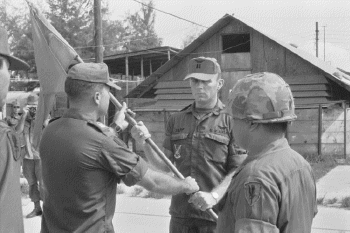
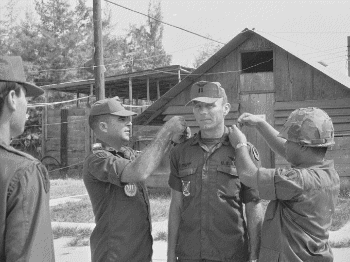
[I have talked somewhat at length with Harold (Paul) Bordeaux (and have had some communication with others under the command of MAJ Johnson, CPT Bordeaux and CPT Sapp) and believe that I have unraveled most of this situation. To protect the personal privacy of several individuals, which would appear to also include the senior headquarters, I am not yet ready to discuss any details of this entire situation...and may never be.]
NOTE: After all of this had taken place (or was taking place), the Battalion Commander of the 212th Combat Support Aviation Battalion, LTC John A. Lovett, took up the task of creating a yearbook. He and his staff, and apparently the last Company Commander of the 220th, CPT David C. Sapp, appear to have opted to restore the logo/nick name of the 220th Aviation Company to CAT KILLERS in its 1971 year of service in Vietnam.
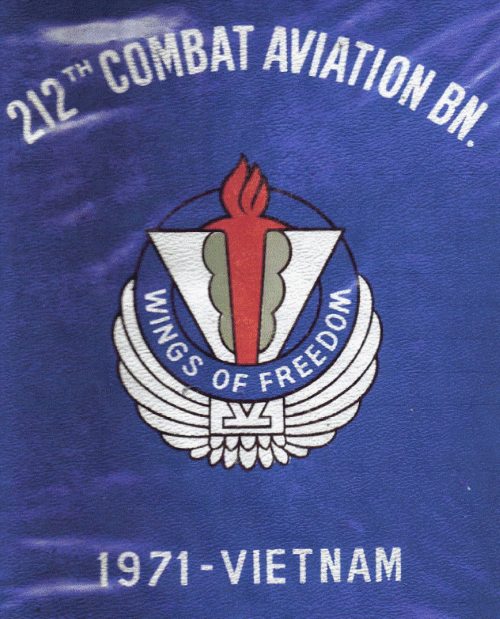
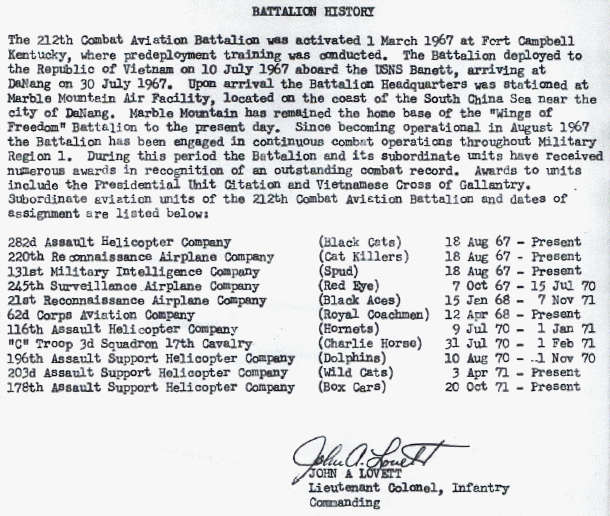
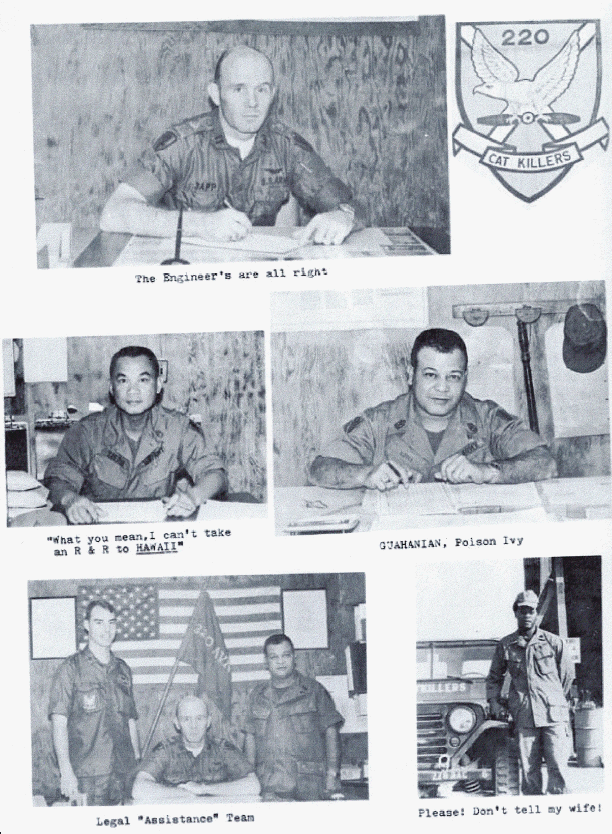
In late June the company supported Fire Support Base Fuller (no other information has been located to date).
On 10 August, CPT Paul Jennings Bates, Jr. and SP5 Thomas Albert Dolan, Aerial Observer, 101st Military Intelligence Company became our last losses—both of whom are still carried as MIA from their mission in the DMZ area.
In September there was an influx of aviators up to 160% of authorized strength that continued into October. During September 5th through 19th the company increased its support to the ARVN 1st Division for Lam Son 810. (Little is known of this operation near Khe Sanh.)
During September and October the 2nd Platoon was deployed to Da Nang / Marble Mountain in support of the ARVN 1st Infantry Division and Hq XXIV Corps. The 3rd Platoon supported the 101st Airborne Division in the A Shau Valley, then moved to Khe Sanh and the DMZ Tri Borders area. The 4th Platoon continued support of the 108th FA Group in Quang Tri Province and the DMZ area of Northern I Corps. I have found no specific mention noted about the 1st Platoon during this time; however, from various communications with some members of the unit, it appears that the 1st Platoon was maintained at Phu Bai in a role of general support throughout the Northern I Corps area.
In October Typhoon Hester with 50 Knot winds and the return of normal wet Monsoon weather created a severe decline of flying hours. However, there appeared to have been no damage of any consequence in the 220th. While I have only limited information about the ferocity of this storm system which varied in intensity throughout Vietnam—other than "it rained a lot—the wind blew—and the mud was something else." I have heard of "sand-blasting" the paint off aircraft that were tied down in the open on the ramp in other locations, in winds up to 100 MPH, before it struck central Vietnam on 23 October. It might be interesting to hear more about this particularly significant weather event.
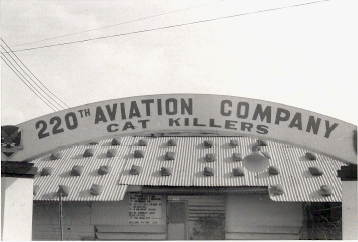 1971
1971
(Note the photo of the sand bags that were placed on the roofs of the buildings to hold the sheet metal down. Photo courtesy of Dick Wells.)
The Company received instructions to begin Stand-Down on 24 November 1971. The Company Headquarters, the platoons and all aircraft and personnel, most of whom were receiving reassignments in Vietnam or ETS orders on a day-to-day basis, depending upon their time of arrival in Vietnam and DEROS (based upon a six month time frame), moved from Phu Bai to Da Nang / Marble Mountain in the vicinity of the 212th CSAB. The main body of the company convoyed in a ground movement from Phu Bai down Highway 1 to Da Nang.
Some of the 220th aircraft were apparently transferred directly to the VNAF in I Corps and all remaining aircraft were then ferried to Long Thanh North, where it is believed they were also transferred to the VNAF.
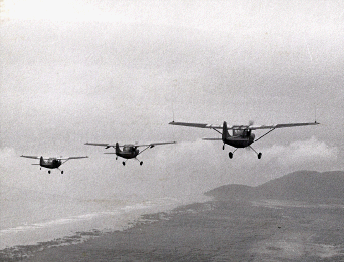
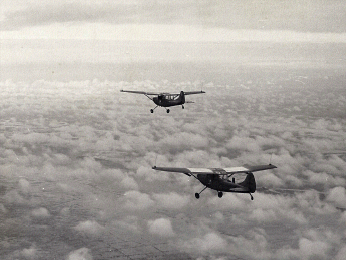
Dick Wells, a WO1 at the time, recently loaned me his copy of the 212th Combat Support Aviation Battalion 1971 Yearbook and a personal scrapbook of photos as well. When I was looking at these great items of history, I noticed the prominence of the CAT KILLER unit patch, and also a triangular 2nd Platoon "Pooch" patch and photos of what appears to be a "Cat Killer" image painted on the aircraft—some things that I had never seen before. When I called Dick and talked with him once again, he informed me that the 4th Platoon "Pooch" patches were in existence when he arrived in the 220th in 1971 . He then sent me the photos of the 4th Platoon patches, the 1971 CAT KILLERS patch and the Viet Cong Hunting Club patch—all of which appear to be just another part of our history.
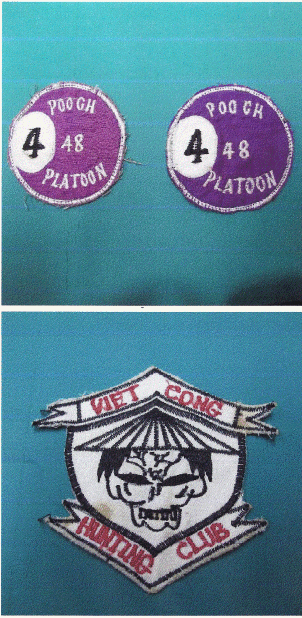
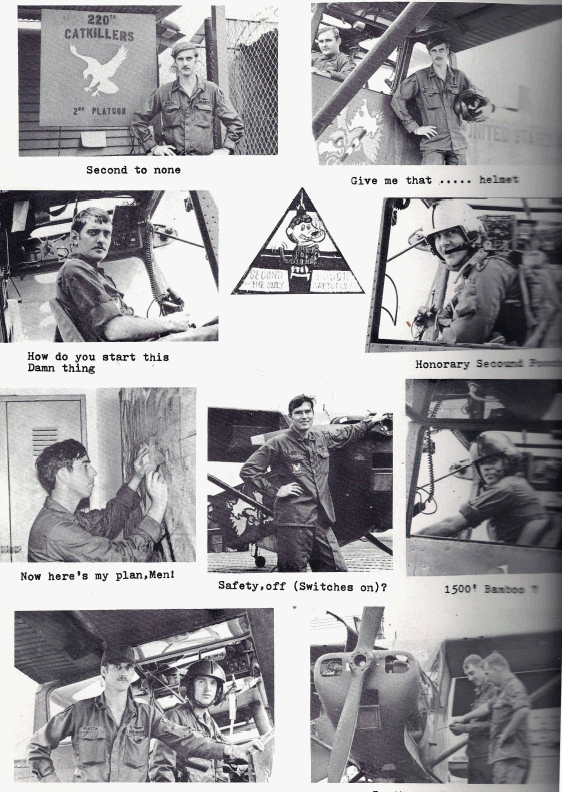
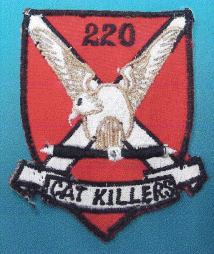
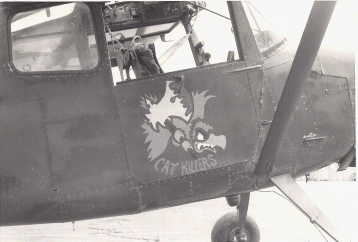
On 23 December 1971 the first and last company sized US Army O-1 Birddog unit to be stationed in I Corps, Vietnam, the 220th Aviation Company (RAC) [actually Utility] ended its operations in the Republic of Vietnam. In accordance with records maintained by the Department of the Army in the Office of the Chief of Military History, the 220th Aviation Company (Utility) was then Inactivated on 26 December 1971 in Vietnam (actually in Da Nang, near the Headquarters, 212th Combat Support Aviation Battalion).NOTE: We have learned that the 219th RAC was also then in the status of stand-down, and according to their Unit History on their web site, ended operations and stood-down on 23 December 1971. (From their unit history on their web site we also now know that the 219th had been activated at Fort Hood, TX, in 1965.) The 74th Aviation Company (SAL) "Aloft" which was formed from the assets of the 73rd Aviation Company (SAL) "Warriors" in Vietnam in March 1965 [the 73rd was actually in Vietnam in 1963 and had its aircraft "farmed out" throughout the Republic of South Vietnam] was the second of the first Army O-1 units in Vietnam. The 74th Aviation Company was then also the last US Army O-1 unit to stand-down in Vietnam in March 1972.During its final year the 220th flew 7,748 sorties for a total of 18,434 hours.(We are searching for photos of any Inactivation Ceremony that would assist in bringing closure to this great organization.)
Reflections:
The construction of the sign at the entry to the Company area was "supervised" and handled by 1SG Joe Morrell, as I recall his collecting voluntary contributions from the officers and men each pay-day during his tour in 1966-67. It was actually constructed in three phases as funds were available — the left pillar/post (completed when the unit was still in tents as seen in historical photos), then the right pillar/post and then finally the completion of the archway, actually after his departure, in 1967. As seen in numerous photos over the years, the landmark appears to have remained unchanged through 1971—220th AVIATION COMPANY—CAT KILLERS.) This appears to have been a long standing error in the original interpretation and painting of the sign—as Dick Quigley, the originator of the call sign and nickname, verifies the use of CATKILLERS (one word) as the way it all started in July 1965.]
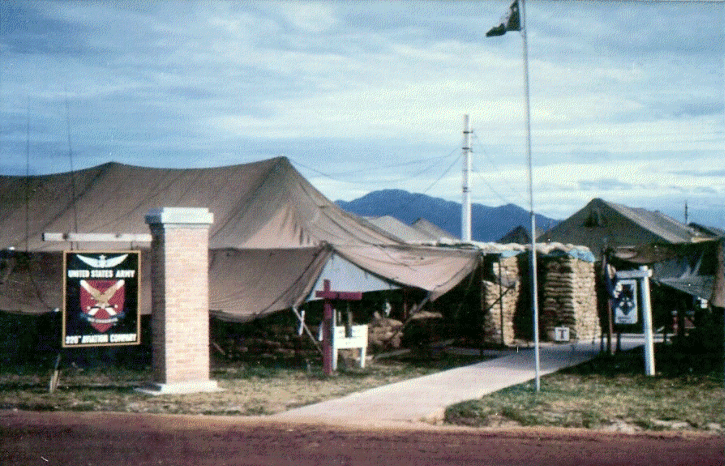 1966
1966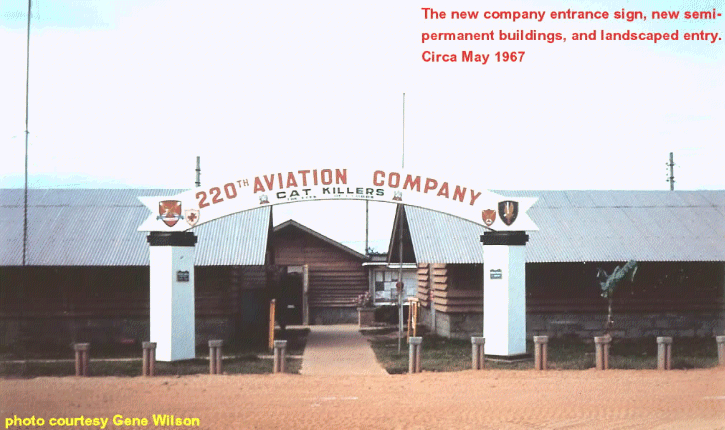 1967
1967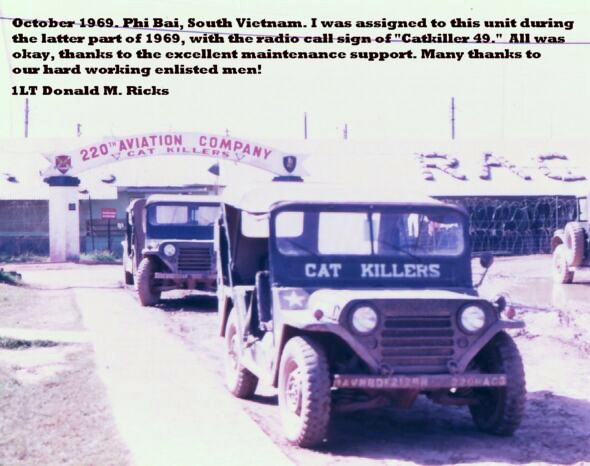 1969
1969
 1971
1971
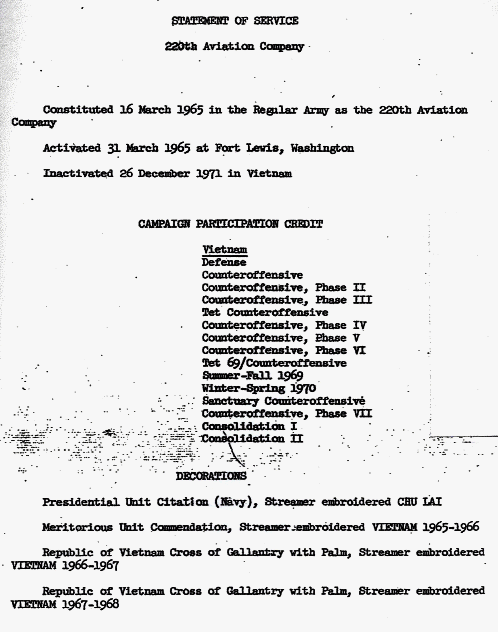
It is further interesting to note that in the earlier years the 220th Aviation Company was included in unit awards and citations as a supporting unit by the USMC units, when they were recognized for outstanding service. However, there appears to have been little to no recognition of supporting units by the US Army XXIV Corps, the 108th Field Artillery Group and/or the 1st Aviation Brigade in the later years. As I recall, unit awards of the Vietnamese Cross of Gallantry w/Palm were usually awarded by the "powers that be" in Vietnam as a gesture of morale building for outstanding service on a periodic basis for one reason or another; however, I have found no such awards for the 220th after 1968 — although the Hq 212th Combat Support Aviation Battalion, Hq 1st Aviation Brigade and other higher headquarters units were recognized by such unit awards in later years.
Without any doubt, our unit soldiers, both Enlisted and Officer, deserved more unit recognition as can be verified by individual and collective acts of highly commendable service after 1968 through 1971. To help insure that all members of the 220th are aware of the Unit Awards and Citations that were bestowed upon the 220th Aviation Company, a copy of page 60 (Table 7), DA Pamphlet 678-2, January 1988, is attached.
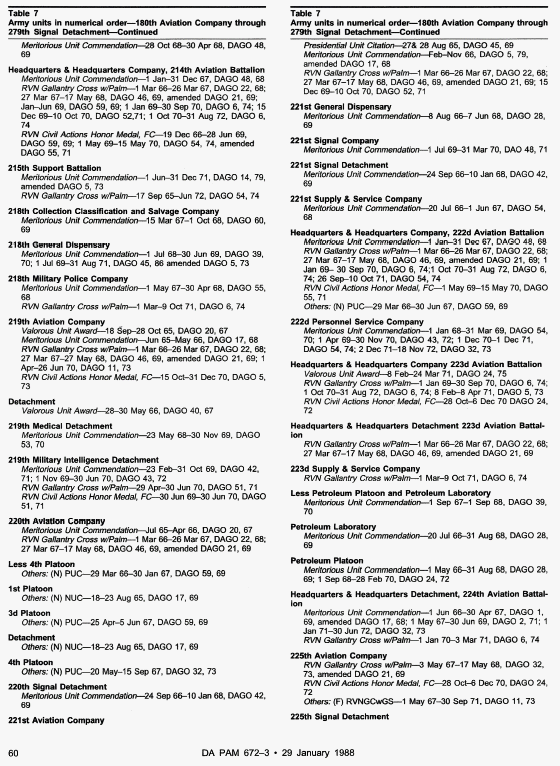
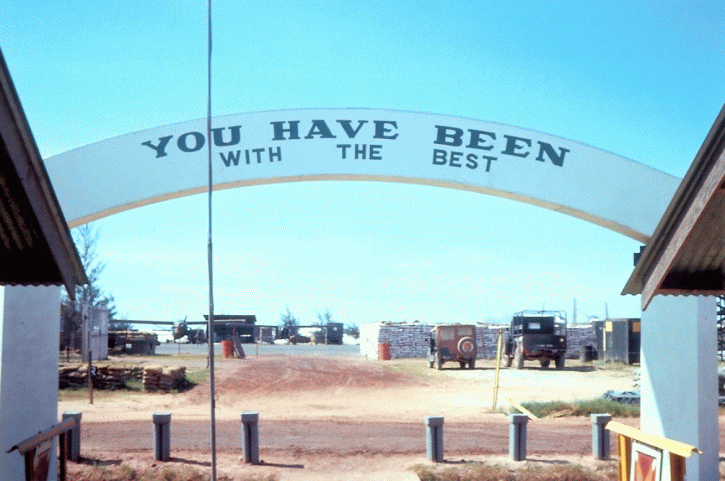
Photo of the back of the Company sign—"YOU HAVE BEEN WITH THE BEST"—as seen by anyone departing the unit area—at least as I last saw it in June 1967.... Truer words have neither been spoken nor written lately:
NOTE: Not known to all of us at the time, the US Army Command and General Staff College Class of 1971-72 at Fort Leavenworth, Kansas, had "Catkillers" Jim Carlin, John Stokes, Gene Wilson, Jim Wisby and "Woody" Woodhurst in residence that year. George Woods was also an instructor (1970-73) in the Department of Larger Unit Operations, at that time, after his completing CGSC in 1969. To my knowledge, this class was the largest to ever attend CGSC in one year (a Vietnam "catch-up" class) and also had the largest contingent of Army Aviators in any known class — so large that our flying hour requirements were waived because it would have been an impossible task for all the aviator students and the necessary supporting cast to accomplish.I am sure that there are similar stories that could be related by our Enlisted Men and young Warrant Officers as they continued to serve as Non-Commissioned Officers and senior Chief Warrant Officers with the US Army.NOTE: I also have various other somewhat random collections of information that I have gathered along the way in this adventure into history and hope to put it all together for just one or more chapters or supplements to the history of the 220th.
CATKILLER OFFICER’S CLUB THREE YEARS OLD:
At the bottom the 1968 History Overview file is a photograph of the newly finished club at Phu Bai, a place where much happened by where most accounts stayed within those walls. Physically, the club looked the same in 1971, but some work continued through those years to improve (and repair damage) as necessary. Here in this historic photo by WO1 Richard “Dick” Wells is a young warrant oficer aviator who would leter become a successful lawyer in his chosen field. Note the added air conditioner, wiring upgrades, sand bags, water tanks and the obvious weathering wear and tear since early 1968. Obviously, the use of the sidewalk was optional during those years:
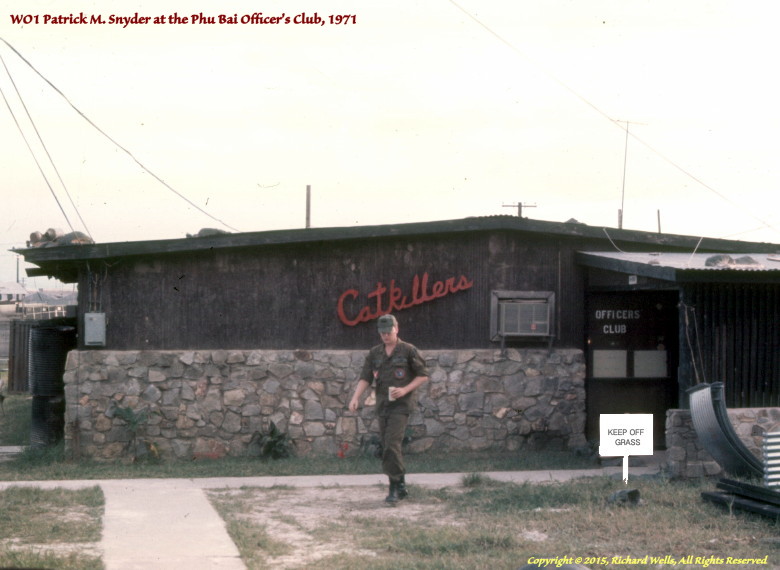
As a side note the this particular club, we would also like to have a photo of the equally famous earlier erected Enlisted Club, perhaps a later shot as well, and how this facility came into being.
The Last Commanding Officer’s Commendable Standdown Performance:
In a manner deserving of commendation and, in retrospect, saving face for the quickly approaching disorganization of the 220th Aviation Company, Captain Thomas A. Shaver took on the multi–task responsibilities as commanding officer and went about conscientiously managing important and diverse standdown requirements:
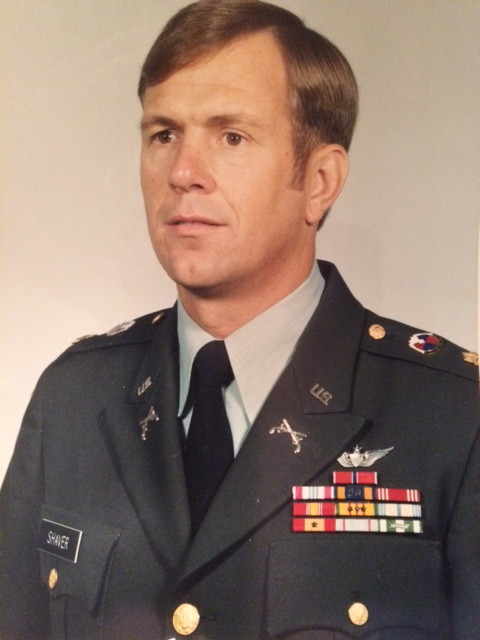
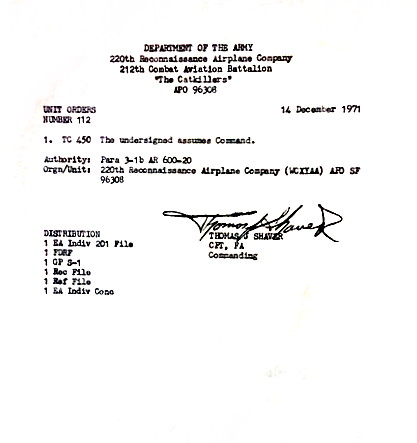
Standdown and Inactivation, After Action Report (AAR):
The final days of the 220th Aviation Company, immediately before its erratic inactivation, are detailed in these copies of surviving pages from the AAR signed by CPT Thomas J. Shaver, Commanding. Captain Sapp and others departed the unit before the signing of this document, as they began to comply with offical reassignment orders. Captain Shaver remained to handle the many remaining tasks and inactivate the unit. According to Tom, there was no official change of command ceremony, but simply and with confidence the rendering of his official signature to the above document:
